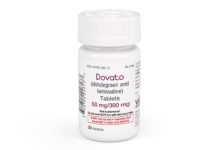Merck announces week 96 data from pivotal Phase 3 drive-forward study of its investigational HIV therapy doravirine.
Merck, known as MSD outside the United States and Canada, today announced Week 96 results from the Phase 3 DRIVE-FORWARD clinical trial evaluating the efficacy and safety of doravirine (DOR), the company’s investigational non-nucleoside reverse transcriptase inhibitor (NNRTI), in combination with other antiretroviral agents, for the treatment of HIV-1 infection in adult patients with no prior antiretroviral treatment history (treatment-naïve). At Week 96, 73.1 percent (277/379) of the group treated with once-daily DOR achieved viral suppression as measured by the proportion of patients who achieved HIV-1 RNA of less than 50 copies/mL, compared to 66.0 percent (248/376) of the group treated with once-daily ritonavir-boosted darunavir (DRV+r) (treatment difference: 7.1%, 95% confidence interval: 0.5, 13.7). These study results were presented today as a late-breaking abstract at the 22nd International AIDS Conference (AIDS 2018) taking place July 23-27, 2018, in Amsterdam.

Previously, the findings at Week 48 demonstrated that once-daily DOR met its primary efficacy endpoint of non-inferiority compared to DRV+r, each in combination with emtricitabine/tenofovir disoproxil fumarate (FTC/TDF) or abacavir/lamivudine (ABC/3TC). These data were presented at the Conference on Retroviruses and Opportunistic Infections in 2017.
“These Week 96 data reinforce the efficacy and safety of doravirine found at 48 weeks, and support the potential use of doravirine in the clinic as an important new treatment option for people living with HIV-1,” said Professor Chloe Orkin, lead for HIV and HIV/Hep C research, Ambrose King Centre, Royal London Hospital.
In DRIVE-FORWARD, 766 participants (n=383 in each treatment group) with no antiretroviral treatment history were randomized and received either DOR (100 mg) once daily or DRV+r (800 mg and 100 mg, respectively) once daily, each in combination with FTC/TDF or ABC/3TC selected by the investigator. In this trial, after 96 weeks of treatment, the proportion of participants achieving HIV-1 RNA less than 50 copies/mL was 73.1 percent (277/379) in the DOR group and 66.0 percent (248/376) in the DRV+r group (treatment difference: 7.1%, 95% confidence interval: 0.5, 13.7). Results for participants with high baseline viral load (HIV-1 RNA greater than 100,000 copies/mL) were 65.4 percent (51/78) for DOR and 65.2 percent (43/66) for DRV+r (treatment difference: -1.1%, 95% confidence interval: -17.6, 15.3). In addition, the mean change from baseline in CD4+ T-cell count at 96 weeks was 224 cells/mm3 for DOR and 207 cells/mm3 for DRV+r (treatment difference: 17.4 cells/mm3, 95% confidence interval: -14.5, 49.3). In terms of resistance, two participants in the DOR treatment group (15 with successful genotype test) developed genotypic and phenotypic resistance to DOR through 96 weeks of treatment.
The most common adverse events occurring in greater than or equal to 10 percent of participants in either treatment group through 96 weeks were diarrhea (DOR 17.0% [65/383], DRV+r 23.8% [91/383]), nausea (DOR 11.7% [45/383], DRV+r 13.6% [52/383]), headache (DOR 14.9% [57/383], DRV+r 12.0% [46/383]), upper respiratory tract infection (DOR 13.3% [51/383], DRV+r 7.8% [30/383]), and viral upper respiratory tract infection (DOR 11.5% [44/383] and DRV+r 13.1% [50/383]). The rate of discontinuation of therapy due to adverse events was 1.6 percent (6/383) in the DOR group and 3.4 percent (13/383) in the DRV+r group.
At Week 96 mean changes from baseline in fasting serum blood lipids for the DOR and DRV+r treated groups in levels of low density lipoprotein cholesterol (LDL-C) were DOR -0.4 mg/dL and DRV+r 14.0 mg/dL (treatment difference: -14.6, 95% confidence interval: -18.2, -11.0); and in levels of non-high density lipoprotein cholesterol (non-HDL-C) were DOR -0.5 mg/dL and DRV+r 17.7 mg/dL (treatment difference: -18.4, 95% confidence interval: -22.5, -14.3). Mean changes from baseline in total cholesterol, high density lipoprotein cholesterol (HDL-C), and triglycerides for the DOR-treated group and the DRV+r treated group were 4.1 mg/dL and 21.9 mg/dL (treatment difference: -18.1, 95% confidence interval: -22.5, -13.7), 4.5 mg/dL and 4.2 mg/dL (treatment difference: 0.4, 95% confidence interval: -1.3, 2.1), and -1.1 mg/dL and 22.5 mg/dL (treatment difference: -25.7, 95% confidence interval: -36.6, -14.7), respectively.
“For more than 30 years, Merck has advanced innovative science to help change the trajectory in how HIV is treated. Today, our work is focused on clinical research that is designed to truly address unmet patient need,” said George Hanna, MD, vice president and therapeutic area head of infectious diseases, global clinical development, Merck Research Laboratories. “We are encouraged by the 96 Week results of the DRIVE-FORWARD trial which support the efficacy and durability of investigational NNRTI doravirine.”


 ПОИСК ПО САЙТУ
ПОИСК ПО САЙТУ  поиск по ресурсному центру
поиск по ресурсному центру 



